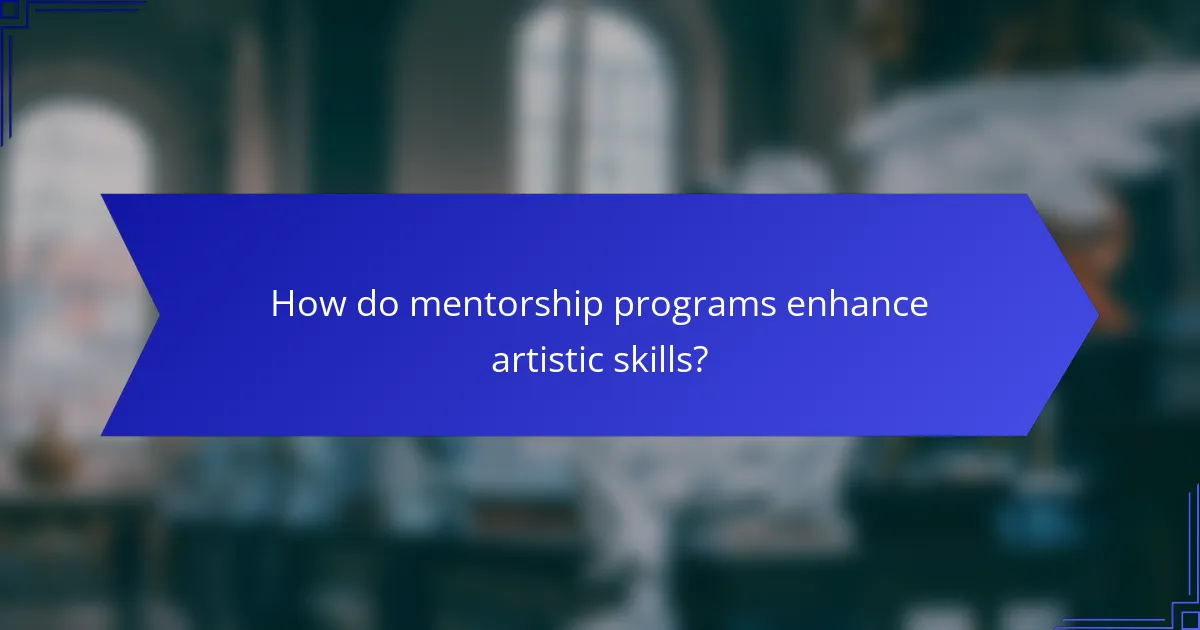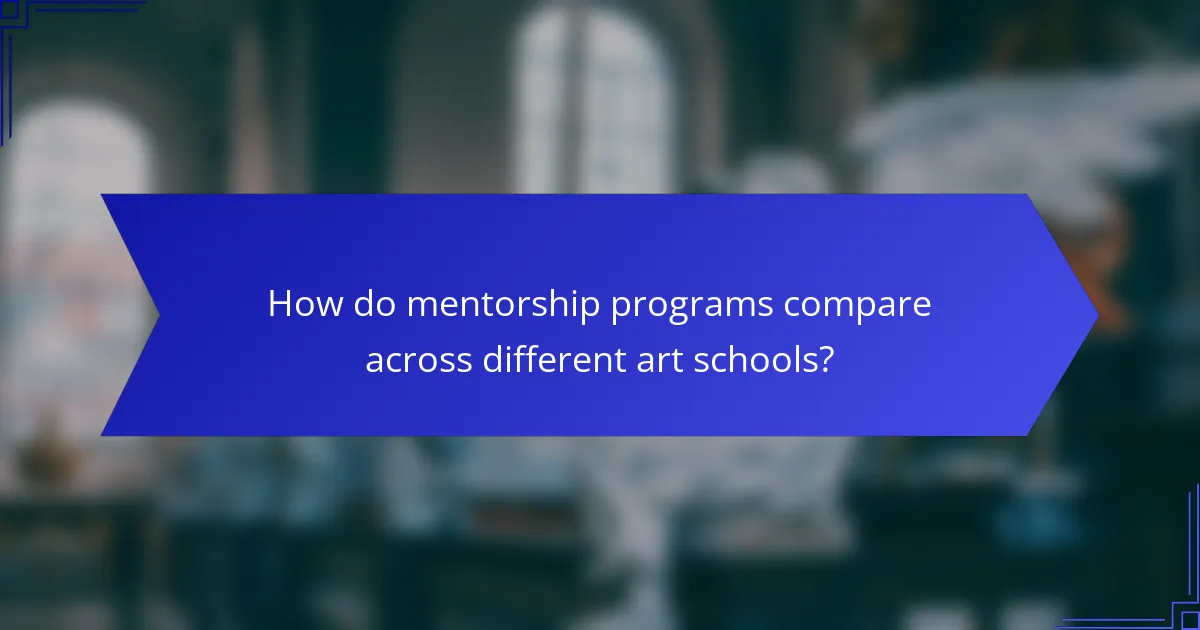Local art schools offer creative mentorship programs that are invaluable for emerging artists seeking to enhance their skills and navigate their careers. By pairing students with experienced mentors, these programs provide personalized guidance that fosters artistic growth and helps refine individual styles. Participants benefit from tailored support, industry insights, and the opportunity to build meaningful connections within the art community.

What local art schools offer creative mentorship programs?
Several local art schools provide creative mentorship programs designed to support emerging artists. These programs typically pair students with experienced mentors who guide them through their artistic development and career planning.
School of Visual Arts in New York
The School of Visual Arts (SVA) in New York offers a robust mentorship program that connects students with industry professionals. This initiative allows students to gain insights into various fields such as graphic design, fine arts, and film.
Participants benefit from personalized guidance, portfolio reviews, and networking opportunities. SVA’s program emphasizes real-world experience, helping students to navigate the complexities of the art world effectively.
California College of the Arts in San Francisco
California College of the Arts (CCA) in San Francisco features a creative mentorship program that fosters collaboration between students and established artists. This program is designed to enhance students’ skills in various disciplines, including painting, sculpture, and design.
Mentors provide tailored advice and feedback, assisting students in refining their artistic voice. CCA also hosts workshops and events that encourage community engagement and professional development.
Rhode Island School of Design in Providence
The Rhode Island School of Design (RISD) offers a comprehensive mentorship program aimed at nurturing artistic talent. Students at RISD are paired with mentors who are leaders in their respective fields, providing invaluable insights and support.
This program includes studio visits, critiques, and opportunities for collaborative projects. RISD emphasizes the importance of mentorship in developing a strong artistic identity and preparing for a successful career in the arts.

How do mentorship programs enhance artistic skills?
Mentorship programs significantly enhance artistic skills by providing tailored guidance and support from experienced professionals. These programs focus on individual growth, helping artists refine their techniques and develop their unique styles.
Personalized feedback from experienced artists
Receiving personalized feedback is crucial for artists looking to improve their craft. Mentors offer insights based on their own experiences, which can help mentees identify strengths and weaknesses in their work. This feedback often includes practical tips on technique, composition, and color theory, allowing artists to make targeted improvements.
For example, a mentor might suggest specific exercises to enhance a painter’s brushwork or recommend resources for developing a unique voice in writing. This direct interaction fosters a deeper understanding of artistic principles and encourages continuous growth.
Networking opportunities with industry professionals
Mentorship programs often provide valuable networking opportunities that can lead to collaborations and career advancements. By connecting with industry professionals, artists can gain insights into market trends, exhibition opportunities, and potential job openings. These connections can be instrumental in building a successful career in the arts.
Participating in workshops, exhibitions, or group critiques organized by the mentorship program can further expand an artist’s network. Engaging with peers and established artists fosters a sense of community and can lead to lasting professional relationships that benefit all involved.

What are the benefits of enrolling in a creative mentorship program?
Enrolling in a creative mentorship program offers numerous advantages, including personalized guidance and professional development. Participants can enhance their skills, gain industry insights, and build valuable connections that can significantly impact their artistic careers.
Improved portfolio development
A creative mentorship program often emphasizes portfolio development, which is crucial for artists seeking to showcase their work effectively. Mentors provide tailored feedback, helping you refine your pieces and present them in a compelling manner.
Through structured critiques and guidance, you can learn how to select your best work, understand market trends, and tailor your portfolio to specific audiences or job opportunities. This targeted approach can elevate your chances of success in competitive art fields.
Access to exclusive workshops and events
Participants in mentorship programs typically gain access to exclusive workshops and events that are not available to the general public. These opportunities can include hands-on sessions with industry professionals, networking events, and exhibitions that showcase emerging talent.
Attending these workshops allows you to learn new techniques, stay updated on industry standards, and connect with peers and potential employers. Engaging in these experiences can significantly enhance your artistic journey and open doors to future collaborations.

How to choose the right mentorship program?
Choosing the right mentorship program involves assessing your personal goals, the program’s offerings, and the mentors’ expertise. Look for programs that align with your creative aspirations and provide a supportive environment for growth.
Evaluate program curriculum and faculty
Review the curriculum to ensure it covers areas relevant to your artistic interests, such as painting, sculpture, or digital media. A strong program should offer a mix of theoretical knowledge and practical experience, allowing you to apply what you learn.
Research the faculty’s backgrounds, including their professional experience and teaching styles. Mentors with industry experience can provide valuable insights and connections that enhance your learning experience.
Consider location and accessibility
Location plays a crucial role in your ability to participate in a mentorship program. Consider programs that are easily accessible, whether through public transport or proximity to your home, to minimize travel time and costs.
Additionally, think about the local art scene. Programs situated in vibrant artistic communities may offer more opportunities for networking, exhibitions, and collaboration with other artists, enriching your mentorship experience.

What is the typical cost of mentorship programs in local art schools?
The cost of mentorship programs in local art schools can vary significantly based on factors such as location, program length, and the institution’s reputation. Generally, you can expect to pay anywhere from a few hundred to several thousand dollars for a comprehensive mentorship experience.
Tuition fees for mentorship programs
Tuition fees for mentorship programs typically range from around $500 to $3,000, depending on the art school and the depth of the program. More prestigious institutions may charge higher fees, while community colleges or local art centers might offer more affordable options.
When considering tuition, check if the fees cover all aspects of the program, including access to facilities, workshops, and one-on-one mentorship sessions. Some schools may offer payment plans or scholarships to help manage costs.
Additional costs for materials and supplies
In addition to tuition, students should budget for materials and supplies, which can add another $100 to $500 or more to the overall cost. This may include art supplies, tools, and any specific materials required for projects during the mentorship.
It’s advisable to inquire about what materials are provided by the school versus what students need to purchase themselves. Some programs may have partnerships with local art supply stores for discounts, which can help reduce expenses.

What are the prerequisites for joining a mentorship program?
Joining a mentorship program in local art schools typically requires a combination of a strong portfolio and some prior experience in art or design. These prerequisites ensure that participants are adequately prepared to engage with the program and benefit from the mentorship offered.
Portfolio submission requirements
Most mentorship programs will ask for a portfolio that showcases your artistic skills and creativity. This portfolio often needs to include a selection of your best work, typically ranging from 5 to 15 pieces, depending on the program’s guidelines.
When preparing your portfolio, focus on quality over quantity. Include a variety of works that demonstrate your versatility and unique style, and ensure that each piece is well-presented. Some programs may also require a brief description of each work, explaining your thought process and techniques used.
Previous experience in art or design
While not all mentorship programs require extensive experience, having a background in art or design can significantly enhance your application. This could include formal education, such as a degree in fine arts or design, or practical experience through internships or freelance work.
Consider highlighting any relevant skills or projects in your application that showcase your commitment to the field. Even if your experience is limited, demonstrating a passion for art and a willingness to learn can make a positive impression on program coordinators.

How do mentorship programs compare across different art schools?
Mentorship programs at art schools vary significantly in structure, duration, and outcomes. Generally, these programs pair students with experienced artists or industry professionals to enhance their skills and career prospects.
Program structure and duration
Art school mentorship programs typically last from a few months to several years, depending on the institution and the specific focus of the program. Many schools offer structured formats, including weekly meetings, workshops, and collaborative projects, while others may provide more flexible arrangements tailored to individual needs.
For example, some programs may include intensive summer sessions lasting 8-12 weeks, while others might extend mentorship over the course of an entire academic year. When choosing a program, consider how the structure aligns with your personal goals and availability.
Alumni success stories and testimonials
Alumni success stories can provide valuable insights into the effectiveness of mentorship programs at art schools. Many graduates credit their mentors with helping them secure internships, gallery exhibitions, or even permanent positions in creative industries.
Testimonials often highlight the personal connections formed during mentorship, which can lead to lasting professional networks. When researching programs, look for case studies or interviews with former students to gauge the potential impact of the mentorship experience on their careers.